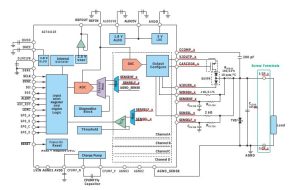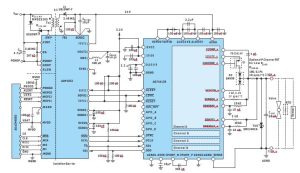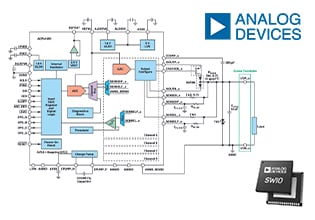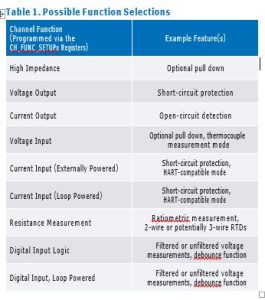Whether used for a process control installation or an industrial automation system, an I/O module or a field junction box has a variety of unique challenges in the whole product life cycle. Product management faces decisions on how many channels and which combinations will be necessary for each product. Electronic designers must decide how to implement the best performance and cost-efficient system for various analog or digital signals in the projects. Installation technicians can be overwhelmed by all the different products and numerous wiring schemes. Wouldn’t life be easier if we could design a system with the ultimate flexibility against such difficulties? Analog Devices’ new product family of software configurable input/output (SWIO) ICs achieve this goal by supporting literally any function and any combination on any pin at any time.
For an industrial programmable logic controller (PLC) or distributed control system (DCS) in process control or factory automation, end-customers and applications have differing requirements. For product managers to define the correct product, strategy and optimization is a huge task.1 One end-customer may require more analog output channels, such as 4 mA to 20 mA, while another one asks for more digital inputs. Or the same customer can ask for more analog channels for one platform, whereas the other platform requires more digital channels. Examples of this dilemma are shown in Figure 1. As Industry 4.0 rises, manufacturers need flexible systems that can quickly and easily adapt to changing requirements, all driven by shifts in consumer behavior and demand. As a result, they can no longer rely on fixed, large-scale systems designed for
mass-market products and predictable demand. Instead, flexible systems that can be reconfigured quickly with minimal downtime and capital investment are required.
SWIO components enable their channels to be programmed, not only as input or output, but also as analog or digital. Furthermore, they can be efficiently set up for reading 2- or 3-wire RTDs or thermocouples.
Software configurable I/O also acts as a bridge to Ethernet-based control networks, as it can further be applied to brownfield installations requiring updates to 10BASE-T1L Industrial Ethernet systems. It enables the development of standardized, configurable field I/O units capable of translating between existing HART-enabled 4 mA to 20 mA sensors and actuators and 10BASE-T1L or 100 meter fiber backhaul.

Figure 2 shows the AD74413R, a quad-channel SWIO device designed to meet process control, factory automation, or building control applications (this article focuses on industrial applications). The device is a fully integrated monolithic solution for industrial input and output operation. The AD74413R features a 16-bit, sigma-delta (∑-Δ) ADC and four 13-bit DACs and is packaged in a 9 mm × 9 mm, 64-lead LFCSP that supports a –40°C to +105°C operating temperature range. Each of the four channels are configured by writing to the configuration registers over an SPI bus whose clock can go up to 24 MHz. Users can refine the default configurations of each operation mode via the AD74413R register map.

The AD74413R’s 16-bit, sigma-delta ADC can measure either current or voltage on one or more of the four channels and up to four diagnostic inputs via a single conversion request. The conversion rate is up to 4.8 kSPS, and optional 50 Hz and 60 Hz rejection filters are available.
The per channel 13-bit R-string DACs are inherently monotonic and linear. These DACs support current outputs up to 25 mA and have open-circuit detection capability for fault diagnostics. Similarly, they can provide voltage outputs with true 0 V to 11 V range.
AD74413R has a highly accurate internal reference to drive DACs and ADCs in cost-sensitive applications, while an external reference may be used when the highest performance is required.
Possible Functions and Operating Modes
Each channel’s function overview can be seen in Table 1. The component can support voltage output, current output, voltage input, current input (externally powered), current input (loop powered), external RTD measurement, digital input logic, and loop-powered digital input. There is also high impedance mode as a default function after power-up or a device reset.
The voltage output amplifier can generate unipolar voltages up to 11 V. An internal low voltage charge pump allows the amplifier to generate a true zero output voltage. In this mode, an external sense resistor provides current feedback (force voltage measure current FVMI approach) while negative feedback over the SENSEL_x pin regulates the correct voltage level.
In current output mode, the DAC provides a current output (typically 0 mA to 25 mA) that is regulated by sensing the differential voltage across the sensor resistor (SENSEL_x and SENSEH_x pins). To decrease power dissipation on the die in cases where a low resistive load is present, one can connect an external PMOS to pass 0 mA to 25 mA output current.
Current input mode can support externally powered and loop-powered configurations. The 16-bit, sigma-delta ADC automatically measures the current through the sense resistor. The filterable sense pins (SENSEHF_x and SENSELF_x) are used for this purpose. In addition, both types of current input functions have additional HART-compatibility mode with minimum 230 Ω receive impedance ensured.2
Voltage input mode measures voltages with the ADC via one of the filtered ports (SENSELF_x) and ground sense. One can choose additional pull-down options against floating voltages. In voltage input mode, thermocouple readings can also be made thanks to a dedicated range setting in the ADC.
The resistance measurement mode biases an external 2-wire RTD with a voltage derived from 2.5 V bias. With the pull-up resistors to bias voltage an accurate ratiometric measurement will be ensured. The low excitation current minimizes power dissipation, reducing the self-heating of the RTD.
Digital input mode supports IEC 61131-2 Type I, Type II, and Type III devices. The thresholds are programmable via a dedicated register. Each channel has a dedi- cated general-purpose output (GPO) and user programmable debounce filtering.
Robustness and Diagnostics
Due to the nature of industrial environments, the AD74413R is designed to be robust in noisy environments and can withstand overvoltage cases such as miswire and surge events. Thanks to on-chip line protectors, the screw terminals do not dump power into the IC when connected to a higher potential than the AVDD pin. Additional TVS diodes can be used to withstand high surges on the
input/output terminals. Moreover, to increase the robustness of the AD74413R, a cyclic redundancy check (CRC) is built into the SPI interface.
Multiple diagnostic features ensure that the AD74413R functions correctly, and they provide warning against most common failure scenarios. The on-chip diagnostics can monitor power supply voltages, reference, die temperature (as alert or shutdown), and screw terminals. Diagnostics for the last factor can help for miswiring detections when there is a failure voltage above AVDD or below 0 V that is connected at the terminals. The external sense resistor further assists for diagnostics as well as for normal operation. For example, it provides short-circuit detection for voltage modes or it helps the regulation of the current output modes. There is also the option for users to program their own diagnostic routines to test connected sensor/actuators, as the AD74113R can force voltages or currents and reading current or voltage responses from the field device.
If an alert condition happens, the ALERT pin asserts. The ALERT_STATUS registered determines the source of the failure.
Companion Solutions
One common application request is that I/O modules or PLCs feature microprocessor isolation or that they have an electronic control unit from the bus side. The data and the power sources should all be galvanically separated. For both purposes, Analog Devices developed a dedicated power and data isolator for the SWIO family. The ADP1032 is a high-performance isolated power management unit (PMU) that comprises an isolated flyback with a buck regulator and data isolation channels. It is shown in Figure 2.
Two regulators are phase shifted for very low electromagnetic interference (EMI). The current mode flyback controller can supply 6 V to 28 V. It has undervoltage lockout (UVLO), overcurrent/overvoltage protection, enable control, soft start, and slew rate control. Moreover, it has seven low power digital isolation channels—four for SPI and three for general-purpose communication.

When HART modulation is required, an AD5700 can provide modem functionality for AD74413R-based systems.
Since the scope of this article encompassed industrial applications, we mainly discussed the AD74413R. There is also a lighter version, called AD74412R, that is targeted to building control applications. It has a reduced operating temperature range of –40°C to +85°C, more relaxed current input and output accuracies, and supply voltages up to 26.4 V.
Conclusion
With the right SWIO ICs, manufacturers can develop a platform that replaces multiple aging fixed function I/O modules. Moreover, they can use this technology across multiple end applications where the I/O dynamically changes with each installation. For systems traditionally reliant on control cabinets with multiple I/O modules and specified wiring for each channel type, the need for industrial hardware disappears as end users can now install a single module programmable from the control room, helping to decrease product management, logistic, manufacturing, and support costs. SWIO technology also acts as a bridge to Ethernet-based control networks, since it can be applied to already available installations.
Contributing Author:










